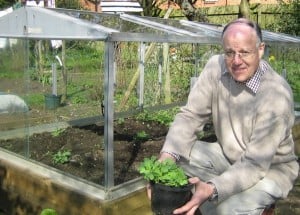Durable Aluminium Framework
All Access Mini greenhouses and Cold Frames are manufactured in the UK using extrusions manufactured from architectural grade aluminium (6063-T6). Architectural aluminium is not pure aluminium but is a stronger and more durable alloy, typically used in buildings where a long life is required. The aluminium has Magnesium, Silicon and small amounts of Titanium, Copper and Chromium added; creating an alloy of greater strength and high corrosion resistance. The T6 designation indicates that it has been heat treated (tempered) and artificially aged to increase its strength. Typically 6063-T6 is well over twice as strong as commercial aluminium alloy (1050-0).

Access provide a 25 year framework guarantee on the aluminium framework, however models manufactured in the 1970’s are still going strong. In fact the image on the right is of the original Cold Frame designer, Don Pearce, with the 1970’s prototype in his garden. The Cold Frames withstand storm force winds (Beaufort scale 10), and snow falls of up to 2’ 6” (750mm) on the roof. In the Great Storm of 1987, where wind speeds reached over 100mph (Beaufort scale 12) the only models that had to be replaced were those damaged by falling masonry!
The extruded profiles are manufactured to our own designs – we do not use standard greenhouse profiles. Not only are our sections manufactured from architectural aluminium, they are much, much thicker than many other greenhouse manufacturers, meaning that our products really are ‘designed to last a lifetime’.

The framework design includes ingenious ‘channels’ to hold the bolts and stop them turning, allowing the main structure to be assembled using just a flat-bladed screwdriver. All nuts and bolts are manufactured either from stainless steel.
For Cold Frames that are placed directly on the soil, deep bottom ‘kick’ rails provide the strength to support the frame with its glazing on slightly uneven surfaces. For units placed on dug earth, all that is needed is a quick rake of the ground to level it before the frame is placed on top.
For lean-to models, fixing points are provided to allow the frame to be solidly screwed back to a wall or fence.
